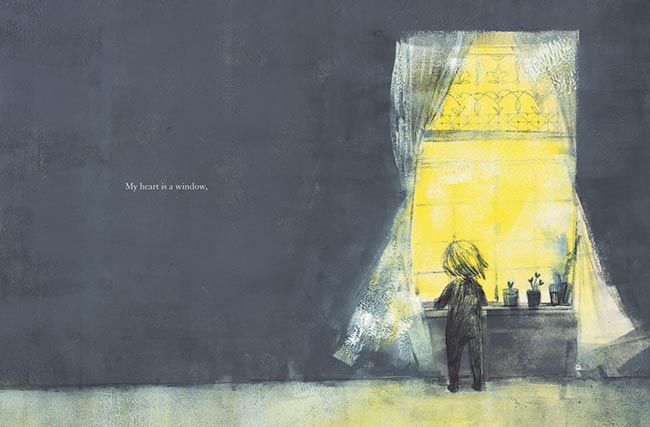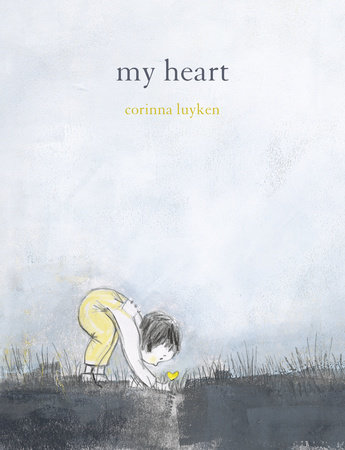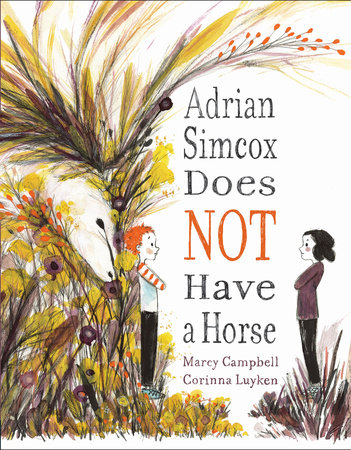Meet the Illustrator: Corinna Luyken
by the Brightly Editors
In this installment of Meet the Illustrator, we chatted with Corinna Luyken, illustrator of The Book of Mistakes and Adrian Simcox Does NOT Have a Horse and the creator of the picture book My Heart. We asked Corinna to share some behind-the-scenes details about her creative process (including the story of her two little animal helpers) and why artistic mistakes are so important to make — and embrace — in front of kids. Read on for the full interview!
What first made you excited about art?
For as long as I can remember I’ve loved to draw. I also remember reading Where the Sidewalk Ends and Rootabaga Stories, written by Carl Sandburg and illustrated by Maud and Miska Petersham, over and over with my mom when I was quite young. I loved the looseness of the ink lines and the silliness of those drawings SO much.
What’s your favorite thing to draw at the moment?
I’m just finishing up my next book as author/illustrator, which is called My Heart, and will be out on January 8, 2019. It has a slightly different look from my other books because I used a technique called monoprint printmaking and pencil. I really enjoyed how the roughness and looseness of the materials lent themselves to experimentation! It’s a world that I really enjoyed living in, and will miss.

Which illustration from Adrian Simcox Does NOT Have a Horse did you especially enjoy creating?
The image of Adrian with head bent, imagining his horse, is one of my favorites.

Also, the cover!
Which characters from your books would you like to spend time with?
All of them! For me, creating a character is similar to falling in love. It’s a process of discovery, and through the act of drawing a character over and over, I learn to love them — even the difficult ones! Once I feel that love, I know I’m ready to start on the actual book.
But I would definitely love to spend some time with all of those kids up in the tree from The Book of Mistakes!

And Adrian and Chloe, at the end of the story, once they are friends. I also think I’d enjoy the company of Chloe’s mom.

And the whole cast of characters from my upcoming book, My Heart, too!
Can you tell us a bit about your workspace?
While working on Adrian Simcox, my family adopted two kittens. Since my studio is inside our house, they quickly became studio helpers. It was really special to watch them grow from tiny kittens into cats as Adrian and Chloe grew from rough sketches into finished characters in a book!
What illustrated book have you read recently and been wowed by?
There are SO many gorgeous books coming out these days. But a recent one that I loved is called Me and My Fear by Francesca Sanna. It is beautiful, well-designed, and such a meaningful story. I also love Forever or a Day by debut illustrator/author Sarah Jacoby. And recently I’ve been revisiting the work of illustrator/author Evaline Ness, including Do You Have The Time, Lydia? and Sam, Bangs & Moonshine. She made so many gorgeous and experimental picture books, starting in the 1960s.
Why do you think art is important for kids? What can grown-ups do to encourage kids to engage with art?
Art is an immediate way for kids to experience the creative process, whether or not they will become a working artist. Being a creative thinker and problem-solver is an important life skill for everyone.
As far as encouraging kids — I think it’s important, as a grown-up, to show that you also make mistakes when you draw. I was talking with a teacher recently who confessed that she was in charge of an after-school art club … but she was unwilling to draw in front of the kids! She felt embarrassed at the thought of them seeing her “limited” skill as an artist. To me, that is exactly why she should draw with them. Even if you don’t think you can draw well, it is important to let kids see you DRAW. Otherwise, you are sending a message that the only artists in the room are the people who seem “good” at this art thing, the kids who can put pencil to paper and make something that looks semi-realistic. Which is absolutely untrue. I was never the “best” artist in my class, but I LOVED to draw. And that love, more than any skill, is what makes an artist. By modeling that people who can’t “draw well” shouldn’t draw at all, we are teaching our children that creativity is not for everyone. And this couldn’t be farther from the truth!
Likewise, if you are a parent or a teacher and you do have technical drawing skills, it’s important to make drawings that don’t look perfect. We all have a desire to seem good at what we do, especially when there is an audience. But when you are making art with kids, it’s important to model what the creative process actually looks like — and nothing about creativity is perfect! Creativity is messy. It is a constant dance between what you want the thing to look like and what you have actually been able to create. But inside that dance there is SO much possibility and beauty.
So whether you are introducing an art activity to a class or drawing with your own children, I would say let them see you make mistakes, let your art be imperfect. This is how you show them that their drawing doesn’t have to be perfect. This is how you make art FUN. When I am in classrooms, I always try to always make a mistake on purpose as I introduce a project. Then I show a few different ways that I could recover from or transform that mistake. It lightens the mood in the class immediately. A mistake, from the teacher, is like an open doorway that says everyone is welcome.
What’s the best name for a color that you’ve ever heard?
I’ve always loved the word “chartreuse.”
-
Get the Books:
-
Adrian Simcox Does NOT Have a Horse
Also available from:The Book of Mistakes
Also available from:







